Hammer is a tool in which heavy metal is mounted on a handle,
The hammers are used for various applications, from pressing a nail into the wood to medical examination of nerves in the legs.
Different types of hammer, parts of hammers , its uses and the making of hammer is discussed in this article.
The below figure shows a typical example of a hammer.
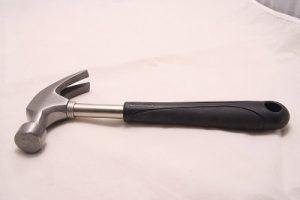
Credit: https://commons.wikimedia.org/wiki/File:IKEA_hammer.jpg
Different types of hammer and their uses
There are different types of hammer in the industry, each have particular uses. Some of therm are listed below,
Claw hammer
The main application of a claw hammer is to push the nail into an object or pull the nail from the object.
The main difference between a regular hammer and a claws hammer is the part claw, which helps pull the nail from the object.
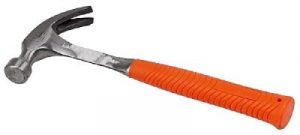
Cross peen hammer
The main applications of cross peen hammers are to push the nail into an object. The advantage of a cross peen hammer is, it can be used to hammer the nail when there is a restriction in space.
Both the surfaces are flat. The cross-section of one side of the hammer is circular, which can be used for general purposes. The other side has a rectangular section with a small cross-sectional area. This side is known as peen. It can be used when the space is restricted.
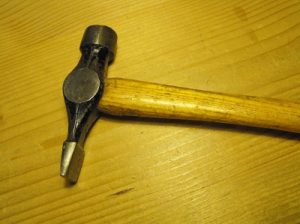
Straight peen hammer
The difference between straight and cross peen hammer is the peen is oriented 90o with each other. The application is similar to cross peen hammer.
Ball peen hammer
The ball-peen hammer is also similar to a straight peen hammer. However, the peen shape is hemispherical in the case of the ball-peen hammer.
The peen surface is used for rounding the edges of metals, for example, in the case of riveting.
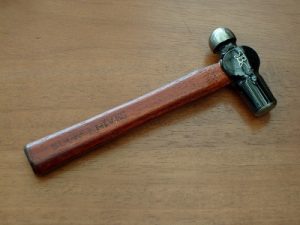
Sledge hammer
These are large hammers. The primary purpose of this is to break large rocks and concrete. Both the shape of the hammer is flat round and symmetrical. It has a large handle, and the weight is 3-16lbs
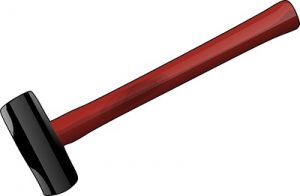
Clinical hammer
Doctors use the clinical hammer. It is also called a reflex hammer. The primary purpose of these hammers is to study nerve conduction in the human body.
The hammerhead is made up of rubber. The doctors hammer on the nerves and observe the reflexes; hence it is called the reflex hammer.
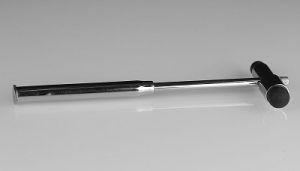
Club hammer
A club hammer is miniature of a sludge hammer. The weight, size, and length of the handle are less compared to the sledge hammer. However, the shape of the hammer head is similar to sledge hammer. The handles usually are wood. The weight is around 2-3 lb.
It is used for light demolishing works, chiselling, etc.
Wooden hammer or mallets
The primary purpose of the mallet is to knock the wooden pieces together or to drive chisels etc.
The hammer head is made up of wood in these hammers.
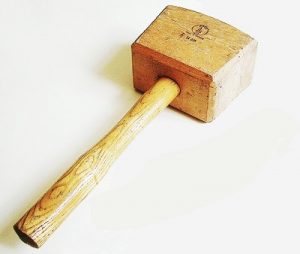
Power Hammer
These hammers are powered by machinery, not with human muscle. In the power hammer, steam is used to create pressure. These are mainly used in the open die forging industry. These are derived from tripping hammers, where tripping hammers are ancient power hammers. In a power hammer, the desired position of hammer is achieved slowly. However, the hammering stroke is fast and instantaneous, hence get better hammering effects.

Parts of hammer
We can separate the parts of a hammer into two categories, Common parts, and special parts. The common parts are there in all types of hammers, and the special parts are available only in a specific hammer, and these are for special purposes.
Common parts of a hammer

Handle
The handle is a long structure in a hammer. When we buy a hammer, we will be looking into the size and shape of the hammer for the user’s comfort. The handle may be wood or steel generally. The steel handle will have the grip to hold the hammer. If the eye diameter is small for a hammer head, the handle may be made in a conical shape to have enough size toward the holding end for easy holding. The cross-sectional shape of the handle can vary; generally, the round is preferred, oval also can be used. The handles should have smooth edges for holding comfortably.
Head
The head is the hammering part. The shape varies tremendously according to the hammer. The hammer at least has one flat side. In sludge and club hammers, both sides are flat. The clinical hammer is an exception; it does not require a flat face in the head.
The head itself has different parts. The particular parts which are peculiar to a hammer are made on the head. The different head parts are discussed below.
Face
The face is the flat surface in the hammer that is used for striking. The hammer has at least one face. The size of the face depends on the application. For example, the sledge hammer has a large face; however, the tack hammer has a small face. The sledge and claw hammer has two faces. Both the faces have the same application; we can use any of these for striking.
Neck
The portion where the head and handle are connected is known as the neck.
Throat
The throat is the portion between the neck and face. In the above figure, we can see the throat section, i.e., for claw hammers, the throat is visible. The sledge and club hammer don’t have a throat.
Cheek
It is the side of the head.
Eye
The eye is the hole that is provided in hammers to connect with the handle. In some hammers, the head and handle come as a single unit. In that case, the hammer doesn’t have an eye. Generally, for wooden handles, we can separate the handle and head. We insert the handle to the eye in these cases. The advantage is that we can change the handle if any damage is occurred to the handle, instead of changing the complete unit.
Special parts of hammer
Different hammers have unique applications. Therefore, the hammer head is made in such a way that the application is achieved easily. Such particular parts are discussed here.
Claw
The claw is provided in a claw hammer to pull out the nail. The nail head is inserted between the two openings of the claw, and then the hammer is pulled so that the nail comes out. The other face is used for the hammering of the nail as usual.
Peen
These are provided in straight, cross, and ball peen hammers. These peens have different applications. The difference between these hammers is the shape of the peen. The straight and cross peen is used when there is not enough space to hammer the nail with the large face like in corners of a wall. The ball-peen is used for rounding the metal edges.
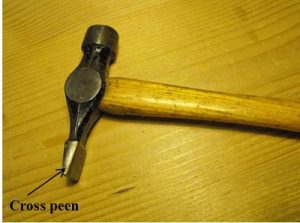
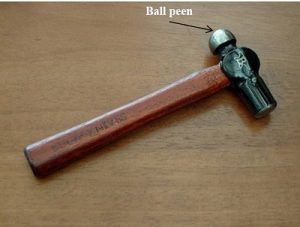
Material used to make the hammer
The hammer’s head is made of strong material, as it has to withstand the repeated blow. Generally, heat-treated high carbon steel is used. The high carbon in steel provides high hardness and strength to the hammer. The heat treatment reduces the stress hence improve the fatigue strength.
Wood or steel is used to make the hammer’s handle. The steel hammers are used for small hammers, and the steel handle is permanently attached to the head. A grip is provided in this steel handle.
The wooden handles are attached to the head manually; hence wooden handle can be replaced. The handle is inserted into the eye of the hammer head and appropriately fixed. The re-fixing is required after continuous use. The wooden handle is used for large hammers (Sledge hammer), as the wood act as a vibration damper.
Hammer making
The hammers are mainly two units head and handle. Generally, both are made separately.
The head is made by hot forging operation. Initially, a large hot bar is cut into small pieces and inserted between two dies. The dies have the mirror shape of the head. One die is stationary; the other is moving. After inserting the metallic bar, the moving die is moved toward the stationary die, by which the inserted metal between the dies takes the shape of the hammer head. After the forging, the hot forged head is cooled to room. Lastly, the surface finishing operation is carried out to remove the unwanted projections in the head.
Metal or wood is used to make hammer’s handle. In the case of the wooden handle, the appropriate shape of the wooden piece is cut, and the handle and head are correctly assembled. A hot extrusion process is used to make the steel handle.
Uses of hammer
The hammers are extensively used in different industries, general works, and real life. As a result, it is one of the most common equipment. Some uses of hammers are listed below.
- Breaking large objects like rock, concrete etc.; The sledge and club hammer is used for this purpose.
- The hammering of a nail; this is the most common use of claw and peen hammers.
- Pulling out the nail; generally claw in the claw hammer is used.
- Forging; in the forging industry, hammers are extensively used. Peen hammers and club hammer is generally used in in the case human forging. The power hammers are used for significant shape change.
- Carpentry, the wooden mallets are used by carpenters to strike wooden components.
- Examining the reflex of the human nerve; the clinical hammers are designed for this purpose. Doctors use this hammer to strike at a specific location in the nerve and observe the reflex; based on the reflex, the doctor finalizes whether the nerves are working correctly or not.
Choosing hammer
We have to follow some steps to choose a hammer. This is basically user-centric, i.e. It is based on your comfort. Basically, we have to follow three steps, which are discussed below.
- Select hammer based on the application
We have to select the hammer according to the application. For example, if your application is striking and pulling out nails, you should go for a claw hammer, and if you want to break a block of concrete or rock, you should choose a sledge hammer.
- Select the weight and size of the hammer
The weight and size are the next parameters. Next, we have to choose the weight and size of the hammer. The size here represents the size of the face. The size of the face should be so that, when we use the hammer, it won’t miss the nails. The weight is concerned when we chose a sledge hammer. The weight should be high for better hammering effect; however, the person should be able to lift the hammer with that weight easily.
- Select the grip
The grip of the hammer is essential. It is for human comfort. If the hammer grip is not chosen correctly, the hand may feel pain and limit the hammer’s continuous usage. The steel hammer comes with the proper grip. However, you should check it once. In the case of wooden handles hammer, the size of the holding end should be enough for the person to hold it properly.
FAQs
What is the metal part of a hammer called?
Generally, the hammers have a metallic part and a wooden part.
The metallic part of the hammer is called as the head of the hammer. The shape and size of the head vary according to the applications.
How many parts does a hammer have?
The hammers have different parts according to the application.
Generally, we can say the hammer has ten parts: Grip, Handle, Neck, Eye, Throat, Face, Head, Cheek, Eye, Claw, or peen.
All these parts are not necessary. For example, in a claw and peen hammer, all these parts can be seen; however, in a sledge hammer, the claw or peen and throat are not present.
What is a hammer drill?
The drill is the equipment used to make a hole in an object; the object may be a wall, wood, or a metallic piece.
A typical drill operates by rotating the cutting tool. While the cutting tool cuts the material, the operator has to push the drill into the hole. If the object is too strong, like a concrete block, the manual pushing may not be enough to push the drill into the hole.
In a hammer drill, a hammering effect is provided to the drill bit additional to drilling; hence the drilling operation becomes easy. Therefore, the hammering effect reduces the manpower required.
What is a piano hammer?
The piano is a musical instrument in which a string is vibrated, and we hear the sound of vibration.
The piano hammer is used to make the vibration in the string when we press a key in the piano.
There are three components to make sound in piano. The keys, hammers and strings. The piano has 88 keys. When one key is pressed it actuates the hammer connected to that key and the hammer strikes a string or set of strings; thereby, the strings start vibrating. Thus, we hear the vibration of these strings. Each hammer strike produces a different set of vibrations; hence distinct sound is produced for each key.
There is another mechanism known as a damper to stop the vibration of these strings.
The given figure shows different parts of a piano mechanism. The hammer mechanism can be seen in the figure.
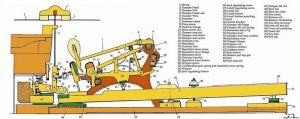
Why is it good to make hammers out of high carbon steel?
Heat treated high carbon steel is used to make the hammer head.
The high carbon in steel provides high hardness and strength to the hammer. The heat treatment reduces the stress hence improve the fatigue strength.
What is a hammer mill?
The hammer mill is mechanically powered hammer that is used in various industries.
Hammer mills are used for crushing large materials into small pieces by the continuous action of tiny hammers. The hammers are attached to a rotor, which rotates at high speed. A cylindrical drum covers the whole rotor hammer mechanism. The drum has two openings, the material to be crushed is inserted from the top, and the fine materials are taken from the bottom. The main application of hammer mills is crushing large rocks into small pieces, shredding automobile parts, etc.
What are mechanically powered hammers?
There are two types of hammers, mechanically powered and Hand powered.
The mechanically powered hammers are different from man-powered hammers.
The mechanically powered hammers use energy from a source other than manpower. The structure of a mechanical hammer is entirely different from the regular hammer; however, the working principle is the same. Examples of mechanically powered hammers are hammer drill, steam hammer, jack hammer, trip hammer, etc.
For more posts on Mechanical Engineering, please follow our Mechanical page.

The lambdageeksScience Core SME Team is a group of experienced subject matter experts from diverse scientific and technical fields including Physics, Chemistry, Technology,Electronics & Electrical Engineering, Automotive, Mechanical Engineering. Our team collaborates to create high-quality, well-researched articles on a wide range of science and technology topics for the lambdageeks.com website.
All Our Senior SME are having more than 7 Years of experience in the respective fields . They are either Working Industry Professionals or assocaited With different Universities. Refer Our Authors Page to get to know About our Core SMEs.